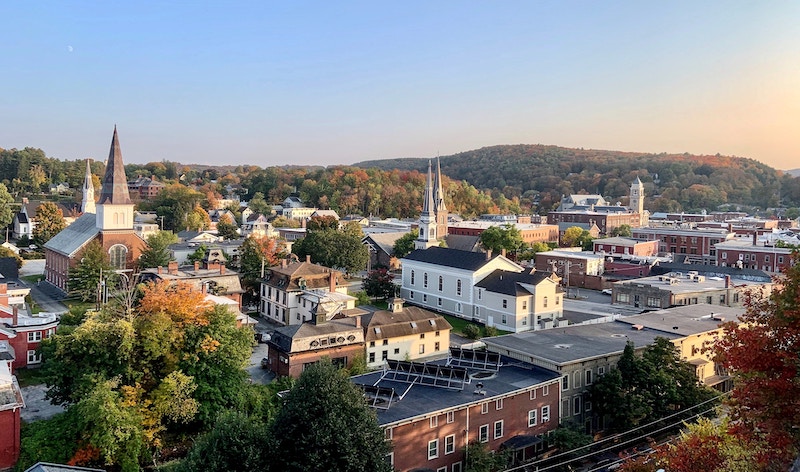Contents
When it comes to local governments and strategic planning, we often think of big cities with vast resources and complex challenges. However, the art of strategic planning takes on a unique and subtly intricate character when applied to small towns. Strategic planning for small cities, towns, and villages requires a distinct approach to strategic planning. In this blog post, we’ll explore the unique nature of strategic planning in small towns, and suggest 5 top strategic planning strategies that may benefit small towns in particular.
Strategic Plans for Small Towns: What Makes It Different?
Close-Knit Community
One of the defining characteristics of small towns is commonly their close-knit community. Residents often know each other, and there is a sense of interconnectedness that runs deep. When it comes to strategic planning, this can be both an opportunity and a challenge. On one hand, the close community can foster strong collaborative processes and a shared vision for the future—it’s much easier to get everyone on board with a shared vision, when everyone is so close knit. On the other hand, this is also the exact feature that can sometimes lead to a community’s unified resistance to change. Successful strategic planning in small towns requires a delicate balance between preserving tradition and embracing innovation.
Limited Resources
Small towns typically have limited financial resources with a smaller tax base compared to larger cities. Museums, art galleries, restaurants, and other amenities often have a tougher margin when it comes to getting through the fiscal year. This scarcity of resources necessitates a more frugal and creative approach to strategic planning. Small towns must prioritize initiatives carefully, seeking to maximize the impact of each investment. This often involves partnerships with neighboring communities, grant applications, and leveraging the skills and expertise of local volunteers.
Extra Emphasis on Quality of Life
Small towns often emphasize the quality of life as a primary goal in their strategic planning efforts. Residents commonly choose to live in small towns for the sense of community, safety, and natural beauty they offer. Therefore, strategic plans in small towns frequently revolve around preserving and enhancing these qualities. Initiatives may include park development, cultural events, and infrastructure improvements that prioritize the well-being of residents.
Enhanced Civic Engagement
In small towns, it’s often easier for residents to get involved in the decision-making process. If the local government makes an effort to include the public in their strategic planning process, they may see heightened civic engagement. Residents in a smaller area may be incentivized to ensure that the plans reflect a small community’s desires and values. Small towns can more readily employ various methods, such as town hall meetings, surveys, and community workshops, to involve residents actively in the planning process.
Strategic planning for small cities requires a tailored approach that takes into account all these unique characteristics and challenges.
Here are five tactics for strategic planning for small cities:
1. Embrace Community Visioning and Collaboration
Residents in a small town are invaluable contributors to a community visioning process during strategic planning. They often bring close-knit relationships, deep local knowledge, and an understanding of the stakes in the town’s future. Engaging community members—and receiving their feedback—ensures that the resulting vision is not only grounded in the town’s unique character but also reflects the aspirations and values of those who call it home.
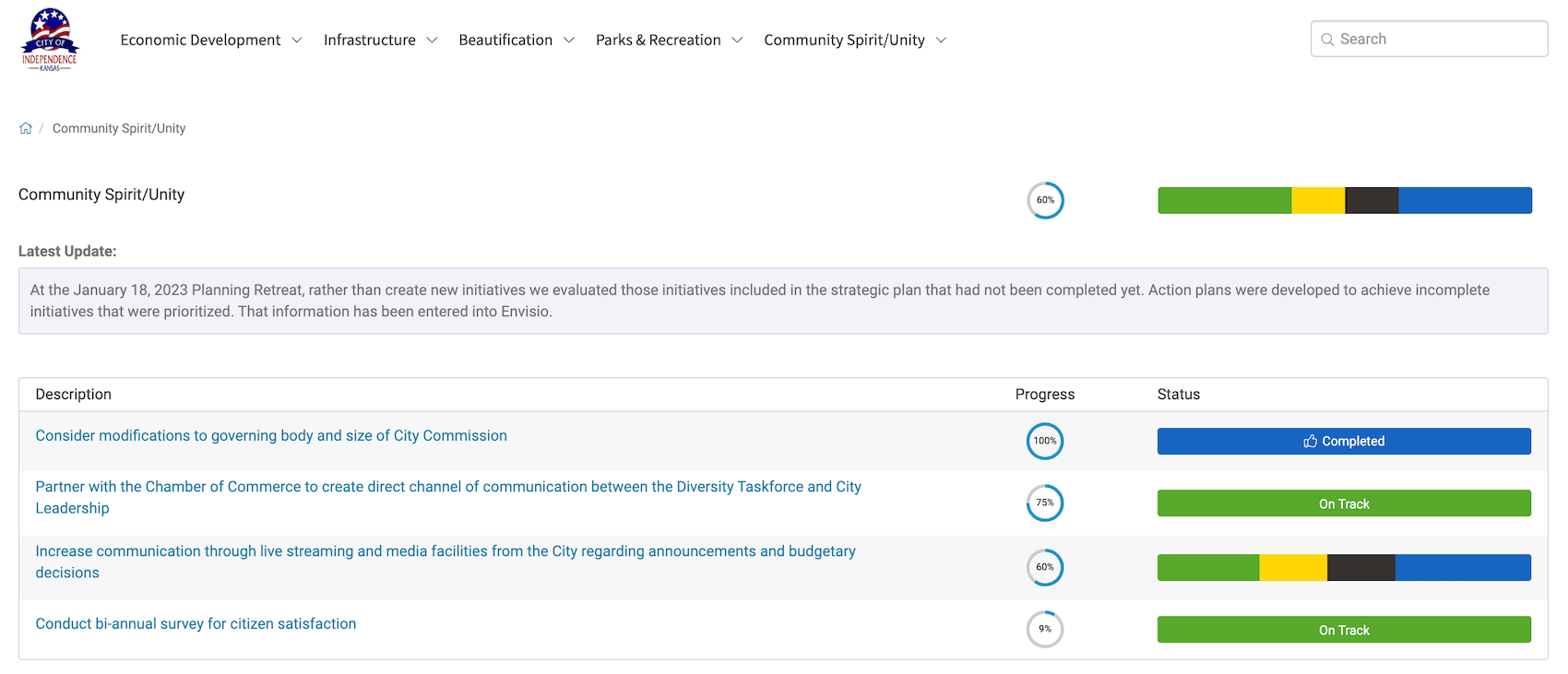
Small Town Strategic Plan Example 1: City of Independence, Kansas Community Based Strategic Plan dashboard, powered by Envisio.
Independence, Kansas (population 8,729) is actively fostering a collaborative atmosphere through their strategic pillar, “community spirit/unity,” which includes a number of initiatives. They conduct bi-annual surveys to gauge resident satisfaction and engagement—a task that is more feasible in a small community. Independence, Kansas, is also working on their communication strategies, such as ensuring that the city’s Facebook page, website, and newsletter remain vibrant platforms for important announcements and communication. Additionally, the city is exploring the adoption of best-of-breed software—from the adoption of public dashboarding and strategy software to new budgeting software—to streamline reservations and improve service order reporting, making it easier for residents to interact with and contribute to their community.
A smaller town makes it easier to engage community members in the strategic planning process—advisory committees or task forces comprising community members who can provide valuable insights and solutions, and community visioning workshops are ways this can be tangibly enacted.
2. Enhance Economic Diversification Initiatives
Small towns often rely heavily on a specific few industries (and, sometimes, only one!)
To enhance economic sustainability, often strategic plans for small towns explore opportunities for diversification. Encourage entrepreneurship, attract new businesses, and invest in local startups that align with the town’s vision.
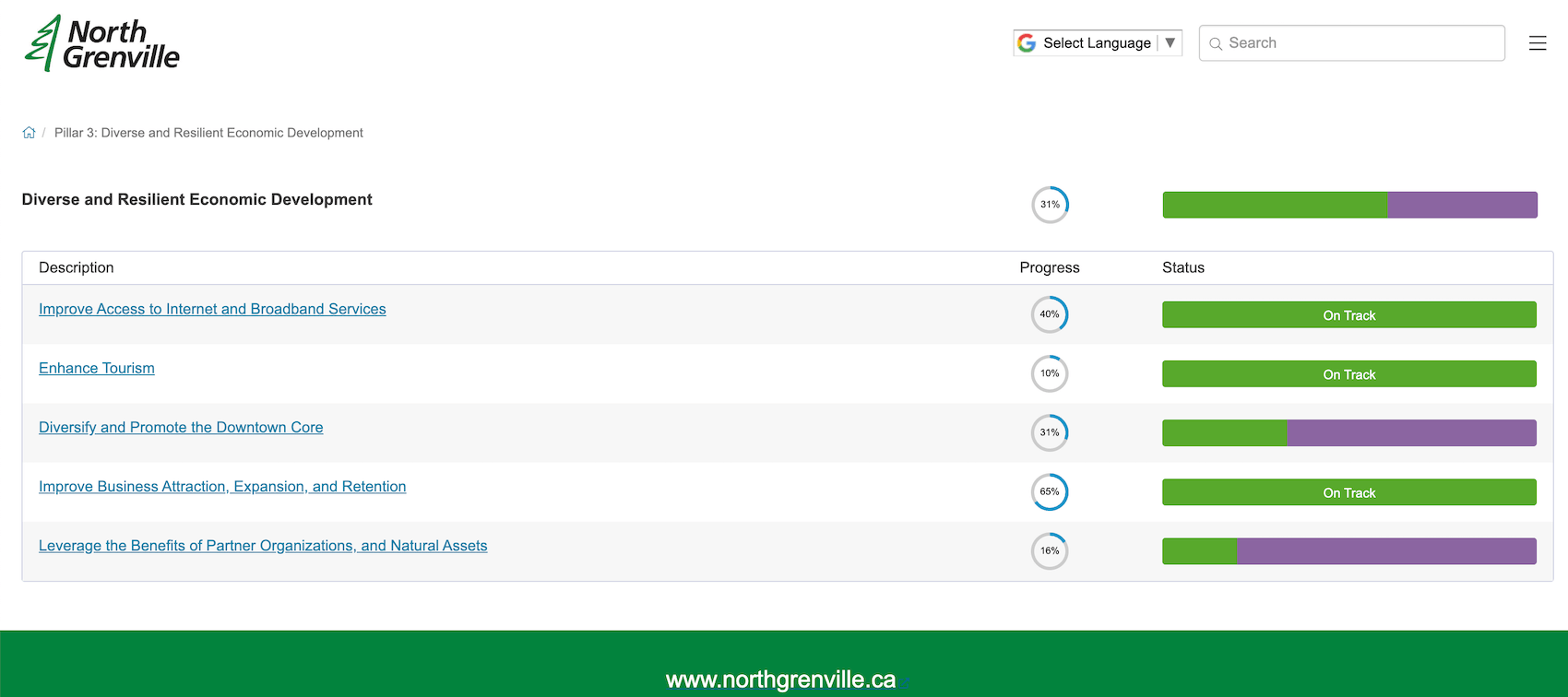
Small Town Strategic Plan Example 2: Municipality of North Grenville’s 10-year Community Strategic Plan dashboard, powered by Envisio.
North Grenville, Ontario, (population 16,451) is actively diversifying its economic portfolio through a series of strategic actions. They are crafting a secondary plan for development of the downtown core, outlining a vision for downtown’s future appearance, specifying desired types of growth, and preserving its unique character. Furthermore, they are undertaking a Downtown Revitalization Plan, aimed at rejuvenating the downtown area. Additionally, North Grenville is developing a comprehensive Economic Development Strategy, which encompasses clear goals and targets for Business Attraction, Retention, and Expansion, thereby fostering a more diverse and resilient local economy.
3. Promote Local Culture and Business
Leverage the unique cultural and historical aspects of your town as a strategic asset. Invest in heritage preservation, promote local arts and culture, and host cultural events that attract visitors and foster community pride.
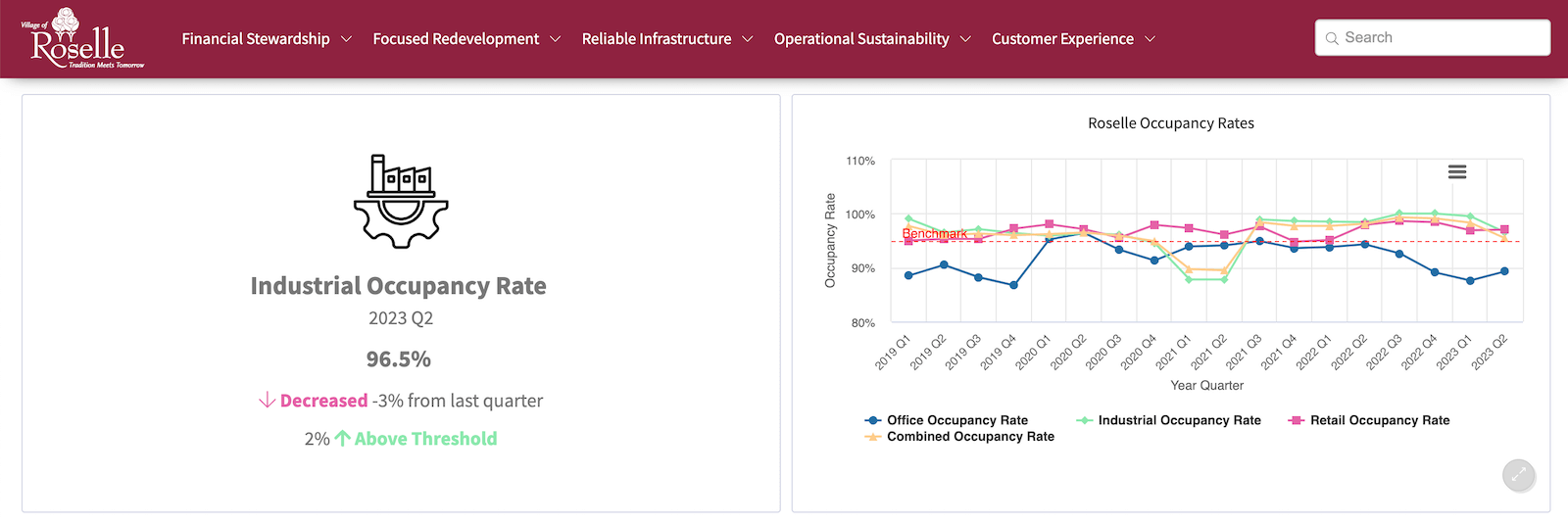
Small Town Strategic Plan Example 3: Village of Roselle 2022-2025 Strategic Plan Public dashboard, powered by Envisio.
The Village of Roselle, Illinois (population 22,763) has an initiative to establish a business recruitment and retention plan that strategically attracts and nurtures businesses aligning with their vision of “Tradition Meets Tomorrow.” This is a great way to promote local culture—for example, businesses that showcase local artisans, sponsor cultural events, support historical preservation, and engage with the community enrich a small town’s identity as a hub of diverse and thriving local culture.
4. Prioritize Multi-Use Facilities in the Strategic Plan
It’s great if a small town can maximize the utility of their existing infrastructure. A community space that can act as a farmer’s market, a faith center, a senior’s activity center, and/or a local government hub, for example, optimizes resource utilization, maximizes community engagement, and fosters a sense of inclusivity. Small towns often face budget constraints and limited space, making it essential to create versatile hubs that can cater to various needs, from education and culture, to social gatherings, and civic engagement.

Small Town Strategic Plan Example 4: Our Ottumwa 2040 Comprehensive Plan dashboard, powered by Envisio.
Through their “Quality of Life” strategic pillar, the City of Ottumwa, Iowa (population 25,350) is embracing the concept of multi-use facilities through its initiative to develop additional library and community meeting space. By expanding and diversifying the function of these spaces, Ottumwa is not only recognizing the evolving needs of its community but also creating versatile hubs that cater to a variety of purposes. This forward-thinking approach promotes inclusivity, accessibility, and community engagement, allowing Ottumwa to foster education, culture, social interactions, and collaborative efforts all under one roof.
5. Aim for Sustainable Development
Small towns are often well positioned to promote sustainability in their strategic plans. They may even have an easier time doing this than larger cities, due to having closer-knit communities, streamlined decision-making processes, and having big dreams on a manageable scale. The overall community buy-in on sustainable practices can become a source of local pride, and smaller towns can often be the early adopters and sites of innovative sustainability initiatives that will eventually be scaled up to larger cities.
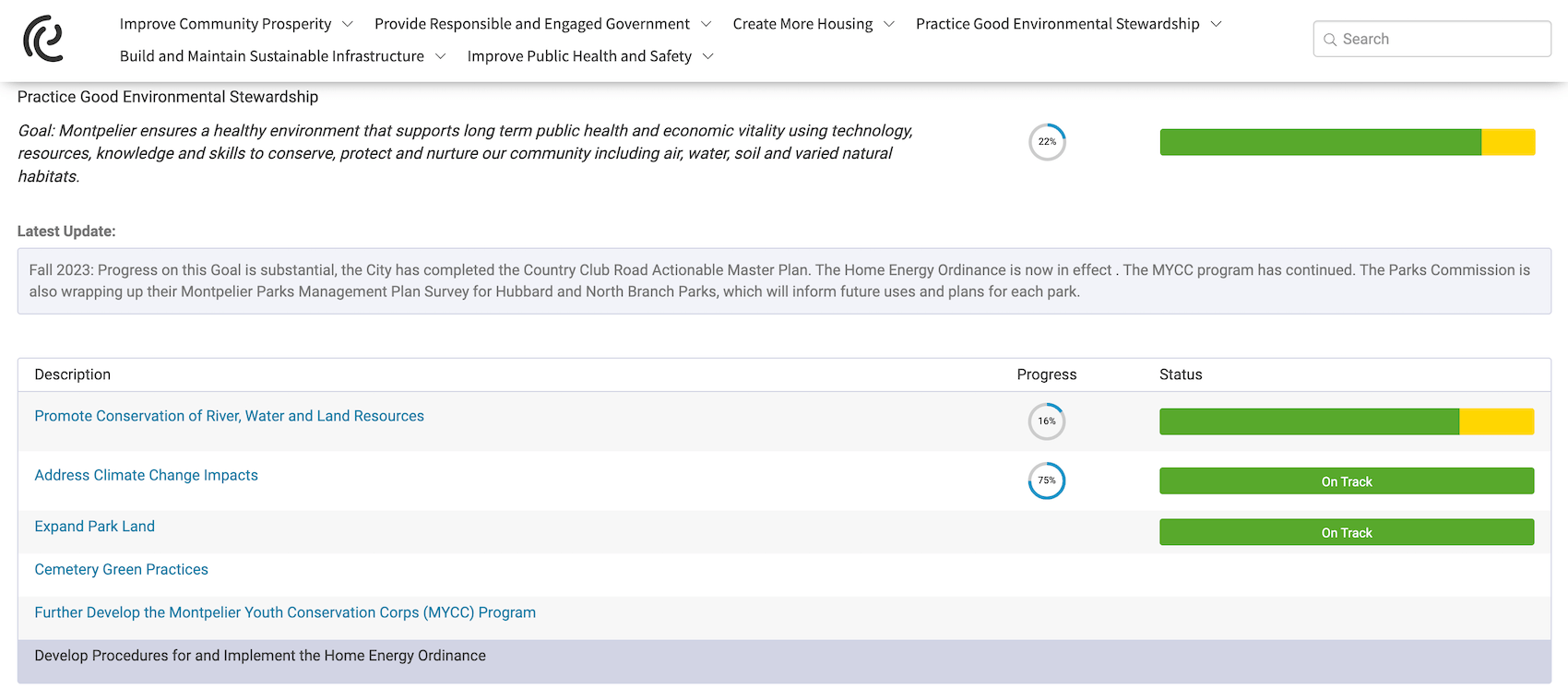
Small Town Strategic Plan Example 5: The City of Montpelier 2022-2023 Strategic Plan dashboard, powered by Envisio.
Montpelier, Vermont, (population 7,484) is aiming to become the first state-Capital to become net-zero by 2030. Their other strategic moves around sustainability sit under their “Practice Good Environmental Stewardship” strategic pillar. It includes recent Fall 2023 updates such as potentially acquiring the Elk’s Club property and implementing the Home Energy Ordinance. Acquiring over 130 acres of property expands their land holdings and provides an opportunity for thoughtful, sustainable land use planning. The new Home Energy Ordinance underscores their dedication to reducing energy consumption and promoting eco-friendly practices among residents. The continuity of the Montpelier Youth Conservation Corps (MYCC) program reflects their long-term commitment to youth and community engagement, fostering sustainability through education and involvement.
—
Strategic planning in small towns is a distinctive undertaking that requires a deep understanding of the community’s values, challenges, and aspirations. It calls for creativity, collaboration, and a commitment to preserving the unique qualities that make small towns special. While the resources may be limited, the passion and dedication of residents often make small towns vibrant places with a bright future. By embracing the specific nature of strategic planning in small towns, communities can chart a unique course that honors their history while fostering sustainable growth, engaging residents, and fostering collaboration.
